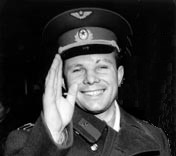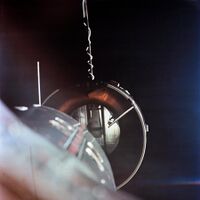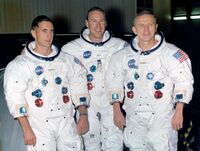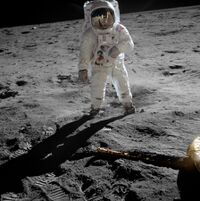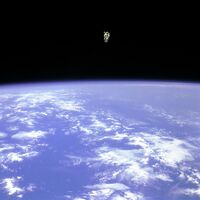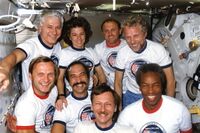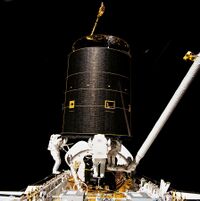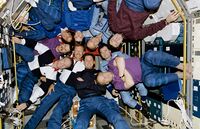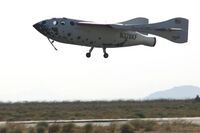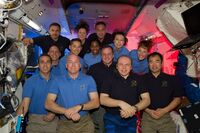Astronomy:List of spaceflight records
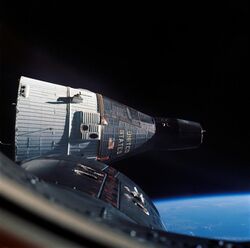
Records and firsts in spaceflight are broadly divided into crewed and uncrewed categories. Records involving animal spaceflight have also been noted in earlier experimental flights, typically to establish the feasibility of sending humans to outer space.
The notion of "firsts" in spaceflight follows a long tradition of firsts in aviation, but is also closely tied to the Space Race. During the 1950s and 1960s, the Soviet Union and the United States competed to be the first countries to accomplish various feats. In 1957, the Soviet Union launched Sputnik 1, the first artificial orbital satellite. In 1961, Soviet Vostok 1 cosmonaut Yuri Gagarin became the first person to enter space and orbit the Earth, and in 1969 American Apollo 11 astronaut Neil Armstrong became the first person to set foot on the Moon. No human has traveled beyond low Earth orbit since 1972, when the Apollo program ended.
During the 1970s, the Soviet Union directed its energies to human habitation of space stations of increasingly long durations. In the 1980s, the United States began launching its Space Shuttles, which carried larger crews and thus could increase the number of people in space at a given time. Following their first mission of détente on the 1975 Apollo-Soyuz Test Project, the Soviet Union and the United States again collaborated with each other on the Shuttle-Mir initiative, efforts which led to the International Space Station (ISS), which has been continuously inhabited by humans for over 20 years.
Other firsts in spaceflight involve demographics, private enterprise, and distance. Dozens of countries have sent at least one traveler to space. In 1963, Valentina Tereshkova became the first woman in space, aboard Vostok 6. In the early 21st century, private companies joined government agencies in crewed spaceflight: in 2004, the sub-orbital spaceplane SpaceShipOne became the first privately funded crewed craft to enter space; in 2020, SpaceX's Dragon 2 became the first privately developed crewed vehicle to reach orbit when it ferried a crew to the ISS. As of 2025, the uncrewed probe Voyager 1 is the most distant artificial object from the Earth, part of a small class of vehicles that are leaving the Solar System.
First independent suborbital and orbital human spaceflight by country
| Country | Mission | Crew | Spacecraft | Launch vehicle | Date | Type |
|---|---|---|---|---|---|---|
| Vostok 1[1] | Yuri Gagarin[1] | Vostok 3KA[1] | Vostok-K[1] | 12 April 1961[1] | Orbital[1] | |
| Mercury-Redstone 3 (Freedom 7)[2] | Alan Shepard[2] | Mercury Spacecraft No.7[2] | Mercury-Redstone[2] | 5 May 1961[2] | Sub-orbital[2] | |
| Mercury-Atlas 6 (Friendship 7)[3] | John Glenn[3] | Mercury Spacecraft No.13[3] | Atlas LV-3B | 20 February 1962[3] | Orbital[3] | |
| Soyuz 18A | Vasily Lazarev, Oleg Makarov | Soyuz 7K-T | Soyuz 11A511 | 5 April 1975 | Sub-orbital | |
| Soyuz TM-14 | Aleksandr Viktorenko, Aleksandr Kaleri, Klaus-Dietrich Flade | Soyuz-TM | Soyuz-U2 | 17 March 1992 | Orbital | |
| Shenzhou 5[4] | Yang Liwei[4] | Shenzhou spacecraft[4] | Long March 2F[4] | 15 October 2003[4] | Orbital[4] | |
| Soyuz MS-10 | Aleksey Ovchinin, Nick Hague | Soyuz-MS | Soyuz-FG | 11 October 2018 | Sub-orbital |
Human spaceflight firsts
Note: Some space records are disputed as a result of ambiguities surrounding the border of space. Most records follow the FAI definition of the space border which the FAI sets at an altitude of 100 km (62.14 mi). By contrast, the NASA-, USAF- and FAA-defined border of space is at 50 mi (80.47 km).
| First | Person(s) | Mission | Country | Date |
|---|---|---|---|---|
| Yuri Gagarin | Vostok 1[5] | 12 April 1961 | ||
|
Alan Shepard | Freedom 7 | 5 May 1961 | |
|
Gherman Titov | Vostok 2 | 6 August 1961 – 7 August 1961 | |
|
|
12 August 1962 – 15 August 1962 | ||
|
Valentina Tereshkova | Vostok 6[9] | 16 June 1963 – 19 June 1963 | |
|
Joe Walker | X-15 Flight 90 | 19 July 1963 | |
| Person to enter space twice (suborbital flights above 100 kilometres (62 mi)) | Joe Walker | X-15 Flights 90 and 91 | 22 August 1963 | |
|
|
Voskhod 1[5] | 12 October 1964 – 13 October 1964 | |
| Spacewalk | Alexei Leonov | Voskhod 2[5] | 18 March 1965 | |
| Orbital maneuvers (change orbit) | Gus Grissom, John W. Young | Gemini 3[5] | 23 March 1965 | |
| Person to fly two orbital spaceflights | Gordon Cooper |
|
| |
| Persons to spend one week in space |
|
Gemini 5 | 21 August 1965 – 29 August 1965 | |
|
|
15 December 1965 – 16 December 1965 | ||
| Civilian in orbit (at the time of flight) | Neil Armstrong | Gemini 8 | 16 March 1966 – 17 March 1966 | |
| Space docking |
|
Gemini 8 and Agena[5] | 16 March 1966 | |
| Multiple (dual) rendezvous (with Agena 10, then Agena 8)[10] |
|
Gemini 10 |
| |
| Persons to exceed 1,000 km above Earth | Gemini 11 | 12 September 1966 –
15 September 1966 | ||
| Spaceflight death (during landing) | Vladimir Komarov | Soyuz 1 | 23 April 1967 – 24 April 1967 | |
|
Walter Schirra | 22 October 1968 | ||
|
|
Apollo 8 | 24 December 1968 – 25 December 1968 | |
|
16 January 1969 | |||
| Solo flight around the Moon | John Young | Apollo 10 | 22 May 1969 | |
|
|
Apollo 11 | 20 July 1969 | |
| Five people in space at the same time |
|
12 October 1969 – 13 October 1969 | ||
|
13 October 1969 – 16 October 1969 | |||
| Person to complete four spaceflights | James A. Lovell | 17 April 1970 | ||
|
James A. Lovell | 11 April 1970 – 17 April 1970 | ||
|
|
11 April 1970 – 17 April 1970 | ||
|
|
Soyuz 9 | 1 June 1970 – 19 June 1970 | |
| People to EVA out of sight of their spacecraft |
|
Apollo 14 | 6 February 1971 | |
|
22 April 1971 – 24 April 1971 | |||
|
|
7 June 1971 – 29 June 1971 | ||
People to travel in a wheeled vehicle on a planetary body other than Earth
|
|
Apollo 15 | 31 July 1971– 2 August 1971 | |
| Deep space EVA (trans-Earth trajectory) | Al Worden | Apollo 15 | 5 August 1971 | |
| Person to be in lunar orbit twice (during separate lunar expeditions) | John W. Young | 16 April 1972 – 27 April 1972 | ||
| People in orbit for four weeks |
|
Skylab 2 | 25 May 1973 – 22 June 1973 | |
| People in orbit for eight weeks |
|
Skylab 3 | 28 July 1973 – 25 September 1973 | |
| People in orbit for 12 weeks |
|
Skylab 4 | 16 November 1973 – 8 February 1974 | |
|
Vasily Lazarev, Oleg Makarov | Soyuz 18a | 5 April 1975 | |
| International docking | Thomas P. Stafford, Vance D. Brand, Donald K. Slayton – USA
Alexei Leonov, Valeri Kubasov – USSR |
Apollo CSM, Soyuz 19 | 17 July 1975 | |
| Crew to visit occupied space station | Vladimir Dzhanibekov, Oleg Makarov | Soyuz 27 visits Salyut 6 EO-1 crew | 10 January 1978 – 16 January 1978 | |
| People in orbit 19 weeks (4 months) |
Vladimir Kovalyonok, Aleksandr Ivanchenkov | Salyut 6 EO-2, Soyuz 29-Soyuz 31 | 15 June 1978 – 2 November 1978 | |
| People in orbit 26 weeks (6 months) |
Leonid Popov, Valery Ryumin | Salyut 6 EO-4, Soyuz 35-Soyuz 37 | 9 April 1980 – 11 October 1980 | |
|
|
STS-1 | 12 April 1981 | |
| Person to fly four different types of spacecraft | John W. Young |
|
12 April 1981 | |
| Person to complete five spaceflights | John W. Young | 14 April 1981 | ||
| Re-use of previously flown spacecraft (orbital) |
|
STS-2 | 12 November 1981 | |
| Four-person spaceflight in a single spacecraft |
|
STS-5 | 11 November 1982 – 16 November 1982 | |
| Five-person spaceflight in a single spacecraft |
|
STS-7 | 18 June 1983 – 24 June 1983 | |
| Six-person spaceflight in a single spacecraft |
|
STS-9 | 28 November 1983 – 8 December 1983 | |
| Person to complete six spaceflights | John W. Young | 8 December 1983 | ||
| Untethered spacewalk |
Bruce McCandless II | STS-41-B[12] | 7 February 1984 | |
| Eight people in space at the same time (no docking) |
|
Salyut 7 EO-3, Soyuz T-10, STS-41-B | 8 February 1984 – 11 February 1984 | |
| 11 people in space at the same time (no docking) |
|
STS-41-C, Salyut 7 EO-3, Soyuz T-10-Soyuz T-11 | 6 April 1984 – 11 April 1984 | |
| People to complete four spacewalks during the same mission | Leonid Kizim, Vladimir Solovyov | Salyut 7 | 26 April – 18 May 1984 | |
| Spacewalk by a woman | Svetlana Savitskaya | Soyuz T-12 | 25 July 1984 | |
| Welding in space | Vladimir Dzhanibekov, Svetlana Savitskaya | Salyut 7, Soyuz T-12 | 25 July 1984 | |
| People in orbit 33 weeks (7 months) | Leonid Kizim, Vladimir Solovyov, Oleg Atkov | Salyut 7 EO-3, Soyuz T-10-Soyuz T-11 | 8 February 1984 – 2 October 1984 | |
| Seven-person spaceflight in a single spacecraft |
|
STS-41-G | 5 October 1984 – 13 October 1984 | |
| Two women in space at the same time | Kathryn D. Sullivan, Sally K. Ride | STS-41-G | 5 October 1984 – 13 October 1984 | |
| Partial crew exchange at a space station | Alexander Volkov, Vladimir Vasyutin replace Vladimir Dzhanibekov | Soyuz T-14, Salyut 7 | 17 September 1985 – 26 September 1985 | |
| Eight-person spaceflight in a single spacecraft |
|
STS-61-A | 30 October 1985 – 6 November 1985 | |
| Deaths during launch |
|
STS-51-L | 28 January 1986 | |
|
Soyuz T-15 from Mir to Salyut 7 back to Mir[13] | 15 March 1986 – 16 July 1986 | ||
| Complete crew exchange at a space station | Vladimir Titov, Musa Manarov replace Yuri Romanenko, Alexander Alexandrov | Soyuz TM-4-Soyuz TM-2, Soyuz TM-3, at Mir | 21 December 1987 – 29 December 1987 | |
| People in orbit 52 weeks (one year) | Vladimir Titov, Musa Manarov | Mir EO-3, Soyuz TM-4-Soyuz TM-6 | 21 December 1987 – 21 December 1988 | |
| 12 people in space at the same time (no docking) |
|
STS-35, Mir EO-7, Soyuz TM-10Soyuz TM-11 | 2 December 1990 – 10 December 1990 | |
| Civilian to use a commercial space flight, and journalist to report on space from outer space | Toyohiro Akiyama – Japan | Soyuz TM-10, Soyuz TM-11 | 2 December 1990 – 10 December 1990 | |
| Three women in space at the same time | Millie Hughes-Fulford, Tamara E. Jernigan, M. Rhea Seddon | STS-40 | 5 June 1991 – 14 June 1991 | |
| Three-person spacewalk |
|
STS-49 | 13 May 1992 | |
| 13 people in space at the same time (no docking) |
|
STS-67, Mir, Soyuz TM-20, Soyuz TM-21 | 14 March 1995 – 18 March 1995 | |
| Ten people in a single spacecraft (docking) |
|
STS-71, Mir, Soyuz TM-21 | 29 June 1995 – 4 July 1995 | |
| Space tourist | Dennis Tito | Soyuz TM-32/31, ISS EP-1 | April 28, 2001 – May 6, 2001 | |
| Person to complete seven trips to space | Jerry L. Ross | 19 April 2002 | ||
| Privately funded human space flight (suborbital) |
Mike Melvill | SpaceShipOne flight 15P | 21 June 2004 | |
| 13 people in a single spacecraft (docking)[14] |
|
ISS, Soyuz TMA-14, Soyuz TMA-15, STS-127 | 17 July 2009 | |
| Four women in space at the same time (docking) |
|
5 April 2010 – 20 April 2010 | ||
| Six spacecraft docked to a space station |
|
9 July 2018 | ||
|
|
|
18 October 2019 | |
|
|
30 May 2020 – 31 May 2020 | ||
| 16 people in space (50 miles) at the same time (no docking) |
|
11 July 2021 | ||
| 14 people in space (100 km) at the same time (no docking) |
|
20 July 2021 | ||
|
|
Inspiration4 | 16 September 2021 – 18 September 2021 | |
|
Inspiration4 | 16 September 2021 – 18 September 2021 | ||
|
|
Inspiration4 | 16 September 2021 – 18 September 2021 | |
| 14 people in orbit at the same time (no docking) |
|
16 September 2021 – 17 September 2021 | ||
| 19 people in space (100 km) at the same time (no docking) |
|
11 December 2021 | ||
|
|
Axiom Mission 1 To ISS | 8 April 2022 – 18 April 2022 | |
|
|
|
5 June 2022 – | |
| 5 women in space at the same time (no docking) |
|
5 October 2022 - 14 October 2022 | ||
| 20 people in space (50 miles) at the same time (no docking) |
|
|
25 May 2023 | |
| 17 people in orbit at the same time (no docking) |
|
30 May 2023 - 31 May 2023 |
Most spaceflights
Most launches from Earth
- 10 launches
- Frederick W. Sturckow (USA), Space Shuttle and SpaceShipTwo (1998–2024)
Note: The six SpaceShipTwo flights surpass the U.S. definition of spaceflight (50 mi (80.47 km)), but fall short of the Kármán line (100 km (62.14 mi)), the FAI definition used for most space recordkeeping.
Most orbital launches from Earth
- 7 launches
- Jerry L. Ross (USA[14]), Space Shuttle (1985–2002)
- Franklin Chang Díaz (Costa Rica/USA[14]), Space Shuttle (1986–2002)
Most orbital launches overall
- 7 launches
- John W. Young (USA[17]) launched from Earth 6 times (two Gemini, two Apollo Command Module, two Space Shuttle) and from the Moon once (Apollo Lunar Module Ascent Stage) (1965–1983)
- Jerry L. Ross (USA[14]), Space Shuttle (1985–2002)
- Franklin Chang Díaz (Costa Rica/USA*[14]), Space Shuttle (1986–2002)
Largest number of different spacecraft at launch (from Earth only)
- 3 spacecraft
- Walter Schirra (USA) – launched aboard a Mercury, Gemini, and Apollo (1962–1968)
- John W. Young (USA) – launched aboard a Gemini, Apollo, and Space Shuttle (1965–1983)
- Soichi Noguchi (Japan) – launched aboard a Space Shuttle, Soyuz, and SpaceX Crew Dragon (2005–2020)
- Shane Kimbrough (USA) – launched aboard a Space Shuttle, Soyuz, and SpaceX Crew Dragon (2008–2021)
- Akihiko Hoshide (Japan) – launched aboard a Space Shuttle, Soyuz, and SpaceX Crew Dragon (2008–2021)
- Thomas Marshburn (USA) – launched aboard a Space Shuttle, Soyuz, and SpaceX Crew Dragon (2007–2021)
- Koichi Wakata (Japan) – launched aboard a Space Shuttle, Soyuz, and SpaceX Crew Dragon (1996–2022)
- Peggy Whitson (USA) – launched aboard a Space Shuttle, Soyuz, and SpaceX Crew Dragon (2002–2023)
- Michael López-Alegría (USA) – launched aboard a Space Shuttle, Soyuz, and SpaceX Crew Dragon (1995–2024)
Largest number of different launch vehicles (overall)
- 4 launch vehicles
- John W. Young (USA) – launched from Earth aboard a Gemini, Apollo, and Space Shuttle, and launched from the Moon aboard the Apollo Lunar Module Ascent Stage
Largest number of different launch sites
- 3 sites
- Frederick W. Sturckow (USA) – Kennedy Space Center (four times aboard a Space Shuttle 1998–2010), Mojave Air and Space Port (aboard a Virgin Galactic SpaceShipTwo in 2018), and Spaceport America (also aboard a SpaceShipTwo, five times 2021-2024).
- John Young (USA) - Cape Kennedy Air Force Station (now Cape Canaveral Space Force Station, twice aboard a Gemini capsule 1965-1966), Kennedy Space Center (four times, twice aboard an Apollo capsule 1969-1971, twice aboard a Space Shuttle 1981-1983), Descartes Highlands (from the Moon aboard an Apollo Lunar Module, in 1971).
- Neil Armstrong (USA) - Cape Kennedy Air Force Station (aboard a Gemini capsule in 1966), Kennedy Space Center (aboard an Apollo capsule in 1969), Tranquility Base (from the Moon aboard an Apollo Lunar Module, in 1969).
- Buzz Aldrin (USA) - Cape Kennedy Air Force Station (aboard a Gemini capsule in 1966), Kennedy Space Center (aboard an Apollo capsule in 1969), Tranquility Base (from the Moon aboard an Apollo Lunar Module, in 1969).
- Pete Conrad (USA) - Cape Kennedy Air Force Station (twice aboard a Gemini capsule 1965-1966), Kennedy Space Center (twice aboard an Apollo capsule 1969-1973), Ocean of Storms (from the Moon aboard an Apollo Lunar Module, in 1969).
- Alan Shepard (USA) - Cape Kennedy Air Force Station (aboard a Mercury capsule in 1961), Kennedy Space Center (aboard an Apollo capsule in 1971), Fra Mauro (from the Moon aboard an Apollo Lunar Module, in 1971).
- David Scott (USA) - Cape Kennedy Air Force Station (aboard a Gemini capsule in 1966), Kennedy Space Center (twice aboard an Apollo capsule 1969-1971), Hadley Rille (from the Moon aboard an Apollo Lunar Module, in 1971).
- Gene Cernan (USA) - Cape Kennedy Air Force Station (aboard a Gemini capsule in 1966), Kennedy Space Center (twice aboard an Apollo capsule 1969-1972), Taurus-Littrow (from the Moon aboard an Apollo Lunar Module, in 1972).
Note: SpaceShipTwo flights are suborbital. SpaceShipTwo flights surpass the U.S. definition of spaceflight (50 mi (80.47 km)), but fall short of the Kármán line (100 km (62.14 mi)), the FAI definition used for most space recordkeeping.
Duration records
Total human spaceflight time by country
Most time in space
The record for most time in space is held by Russian cosmonaut Gennady Padalka, who has spent 878 days in space over five missions. On 28 June 2015, Padalka surpassed the previous record holder, cosmonaut Sergei Krikalev, who spent 803 days, 9 hours and 39 minutes (about 2.2 years) during six spaceflights on Soyuz, the Space Shuttle, Mir, and the International Space Station.[18][19][20] Second place is currently held by Oleg Kononenko, have been in space for Template:Sum days on five spaceflights. Oleg Kononenko, who launched on board Soyuz MS-24 to ISS on 15 September 2023, is on his fifth spaceflight currently and is assigned for a one year long duration ISS mission. If this mission lasts 300–365 days, Kononenko will have spent a total of 1,036-1,101 days in space, exceeding the current record by Padalka. It is expected that Oleg Kononenko will break this record on February 4, 2024 at 07:30:08 UTC.[21] He will thus also become the first person to stay 900 and 1,000 days in space.[22][23]
{{As of|2025| |8} pacefacts">"Astronauts and Cosmonauts (sorted by "Time in Space")". spacefacts.de. http://www.spacefacts.de/english/e_tis.htm. The current missions are listed but not included in day count.</ref> the 50 space travelers with the most total time in space are:
Color key:
- Currently in space
- Active
- Retired
- Deceased
| Rank | Person | Days | Flights | Status | Nationality |
|---|---|---|---|---|---|
| 1 | Gennady Padalka | 878.480 | 5 | Retired | |
| 2 | Oleg Kononenko | Template:Sum | 5 | Active | |
| 3 | Yuri Malenchenko | 827.389 | 6 | Retired | |
| 4 | Sergei Krikalev | 803.371 | 6 | Retired | |
| 5 | Aleksandr Kaleri | 769.276 | 5 | Retired | |
| 6 | Sergei Avdeyev | 747.593 | 3 | Retired | |
| 7 | Anton Shkaplerov | 709.336 | 4 | Retired | |
| 8 | Valeri Polyakov | 678.690 | 2 | Deceased | |
| 9 | Peggy Whitson | 675.158 | 4 | Active | |
| 10 | Fyodor Yurchikhin | 672.860 | 5 | Retired | |
| 11 | Anatoly Solovyev | 651.117 | 5 | Retired | |
| 12 | Sergey Prokopyev | 567.633 | 2 | Active | |
| 13 | Oleg Artemyev | 560.614 | 3 | Active | |
| 14 | Viktor Afanasyev | 555.772 | 4 | Retired | |
| 15 | Yury Usachov | 552.773 | 4 | Retired | |
| 16 | Sergey Volkov | 547.931 | 3 | Retired | |
| 17 | Pavel Vinogradov | 546.939 | 3 | Retired | |
| 18 | Aleksandr Skvortsov | 545.964 | 3 | Retired | |
| 19 | Musa Manarov | 541.021 | 2 | Retired | |
| 20 | Oleg Skripochka | 536.159 | 3 | Retired | |
| 21 | Jeffrey Williams | 534.116 | 4 | Retired | |
| 22 | Mikhail Tyurin | 532.118 | 3 | Retired | |
| 23 | Oleg Novitsky | 531.290 | 3 | Active | |
| 24 | Oleg Kotov | 526.211 | 3 | Retired | |
| 25 | Mark T. Vande Hei | 523.374 | 2 | Active | |
| 26 | Scott Kelly | 520.440 | 4 | Retired[24] | |
| 27 | Mikhail Kornienko | 516.417 | 2 | Retired | |
| 28 | Koichi Wakata | 504.773 | 5 | Active | |
| 29 | Aleksandr Viktorenko | 489.066 | 4 | Deceased | |
| 30 | Anatoli Ivanishin | 476.195 | 3 | Retired | |
| 31 | Nikolai Budarin | 444.060 | 3 | Retired | |
| 32 | Yuri Romanenko | 430.765 | 3 | Retired | |
| 33 | Thomas Pesquet | 396.482 | 2 | Active | |
| 34 | Aleksandr Volkov | 391.495 | 3 | Retired | |
| 35 | Yury Onufriyenko | 389.282 | 2 | Retired | |
| 36 | Shane Kimbrough | 388.728 | 3 | Retired | |
| 37 | Vladimir Titov | 387.036 | 4 | Retired | |
| 38 | Vasily Tsibliyev | 381.662 | 2 | Retired | |
| 39 | Valery Korzun | 381.653 | 2 | Retired | |
| 40 | Michael Fincke | 381.633 | 3 | Active | |
| 41 | Christopher Cassidy | 377.742 | 3 | Retired | |
| 42 | Aleksey Ovchinin | 374.813 | 2 | Active | |
| 43 | Leonid Kizim | 374.749 | 3 | Deceased | |
| 44 | Michael Foale | 373.763 | 6 | Retired | |
| 45 | Aleksandr Serebrov | 372.954 | 4 | Deceased | |
| 46 | Valery Ryumin | 371.725 | 4 | Deceased | |
| 47 | Dmitry Petelin | 370.890 | 1 | Active | |
| Francisco Rubio | 370.890 | 1 | Active | ||
| 49 | Samantha Cristoforetti | 370.239 | 2 | Active | |
| 50 | Donald Pettit | 369.696 | 3 | Active |
Ten longest human spaceflights
| # | Time in space | Crew | Country | Launch date (Launch craft) | Landing date (Landing craft) | Space station or mission type |
|---|---|---|---|---|---|---|
| 1 | 437.7 days[26][27] | Valeri Polyakov[26] | 1994-01-08 (Soyuz TM-18) | 1995-03-22 (Soyuz TM-20) | Mir[26] | |
| 2 | 379.6 days[27] | Sergei Avdeyev[27] | 1998-08-13 (Soyuz TM-28) | 1999-08-28 (Soyuz TM-29) | Mir[27] | |
| 3 | 370.9 days | Sergey Prokopyev | 2022-09-21 (Soyuz MS-22) | 2023-09-27 (Soyuz MS-23) | International Space Station | |
| Dmitry Petelin | ||||||
| Francisco Rubio | ||||||
| 4 | 365.9 days[27] | Vladimir Titov[27] | 1987-12-21 (Soyuz TM-4) | 1988-12-21 (Soyuz TM-6) | Mir[27] | |
| Musa Manarov[27] | ||||||
| 5 | 355.2 days[28] | Pyotr Dubrov | 2021-04-09 (Soyuz MS-18) | 2022-03-30 (Soyuz MS-19) | International Space Station | |
| Mark T. Vande Hei | ||||||
| 6 | 340.4 days | Mikhail Kornienko | 2015-03-27 (Soyuz TMA-16M) | 2016-03-01 (Soyuz TMA-18M) | International Space Station, ISS year-long mission | |
| Scott Kelly | ||||||
| 7 | 328.6 days[29][30] | Christina Koch[30] | 2019-03-15 (Soyuz MS-12) | 2020-02-06 (Soyuz MS-13) | International Space Station | |
| 8 | 326.5 days[31] | Yuri Romanenko[31] | 1987-02-05 (Soyuz TM-2) | 1987-12-29 (Soyuz TM-3) | Mir[31] | |
| 9 | 311.8 days[32] | Sergei Krikalev[32] | 1991-05-18 (Soyuz TM-12) | 1992-03-25 (Soyuz TM-13) | Mir[32] | |
| 10 | 289.2 days[33] | Peggy Whitson[33] | 2016-11-17 (Soyuz MS-03) | 2017-09-03 (Soyuz MS-04) | International Space Station[33] |
Longest single flight by a woman
NASA astronaut Christina Koch holds the record for the longest single spaceflight by a woman (328 days), returning on February 6, 2020.[30] She surpassed NASA astronaut Peggy Whitson's 289 days during Expedition 61 in 2019. In third place is American astronaut Anne McClain with 204 days.[34]
Longest continuous occupation of space
An international partnership consisting of Russia, the United States, Canada, Japan and the member states of the European Space Agency have jointly maintained a continuous human presence in space since 31 October 2000, when Soyuz TM-31 was launched. Two days later it docked with the International Space Station.[14][35] Since then space has been continuously occupied for 24 years, 159 days.[14]
Longest continuous occupation of a spacecraft
The International Space Station has been continuously occupied by a Russian and US crew member since 2 November 2000 (24 years, 157 days).[14][35] It broke the record of 9 years and 358 days of the Soviet/Russian Space Station Mir on 23 October 2010.[35]
Longest solo flight
Valery Bykovsky flew solo for 4 days, 23 hours in Vostok 5 from 14 to 19 June 1963.[36] The flight set a space endurance record which was broken in 1965 by the (non-solo) Gemini 5 flight. The Apollo program included long solo spaceflight, and during the Apollo 16 mission, Ken Mattingly orbited solo around the Moon for more than 3 days and 9 hours.
Longest time on the lunar surface
Eugene Cernan and Harrison Schmitt of the Apollo 17 mission stayed for 74 hours 59 minutes and 40 seconds (over 3 days) on the lunar surface after they landed on 11 December 1972.[37] They performed three EVAs (extra-vehicular activity) totaling 22 hours 3 minutes, 57 seconds. As Apollo commanders were the first to leave the LM and the last to get back in, Cernan's EVA time was slightly longer.[37]
Longest time in lunar orbit
Ronald Evans of Apollo 17 mission stayed in lunar orbit for 6 days and 4 hours (148 hours)[38] along with five mice. For the solo portion of a flight around the Moon, Ken Mattingly on Apollo 16 spent 1 hour 38 minutes longer than Evans' solo duration.
Speed and altitude records
Farthest humans from Earth
The Apollo 13 crew (Jim Lovell, Fred Haise, and Jack Swigert), while passing over the far side of the Moon at an altitude of 254 km (158 mi) from the lunar surface, were 400,171 km (248,655 mi) from Earth.[39] This record-breaking distance was reached at 00:21 UTC on 15 April 1970.[39]
Highest altitude for crewed non-lunar mission
Gemini 11 crew Charles Conrad, Jr. and Richard F. Gordon, Jr. fired their Agena Target Vehicle rocket engine on 14 September 1966, at 40 hours 30 minutes after liftoff and achieved a record apogee altitude of 739.2 nautical miles (1,369.0 km).[40]
Fastest
The Apollo 10 crew (Thomas Stafford, John W. Young and Eugene Cernan) achieved the highest speed relative to Earth ever attained by humans: 39,897 kilometers per hour (11,082 meters per second or 24,791 miles per hour, about 32 times the speed of sound and 0.0037% of the speed of light).[14] The record was set 26 May 1969.[14]
The record for uncrewed spacecraft is held by the Parker Solar Probe at 176 km/s, about 1/1700 (or 0.06%) the speed of light, relative to the Sun. This speed was first reached in September 2023.
Age records
Earliest-born to reach space
Suborbital flight
- Man - Joe Walker (born 20 February 1921), on X-15 Flight 90 on 19 July 1963 (about 12 minutes.)
- Woman - Wally Funk (born 1 February 1939), on Blue Origin NS-16, on 20 July 2021 (about 10 minutes.)
Orbital spaceflight
- Man – Georgy Beregovoy (born 15 April 1921), on Soyuz 3 on 26 October 1968 (81 orbits in about 4 days.)
- Woman – Valentina Tereshkova (born 6 March 1937), on Vostok 6 on 16–19 June 1963 (46 orbits, about 3 days.)
Youngest
Suborbital flight
- Man - Oliver Daemen (aged 18 years and 11 months), on Blue Origin NS-16, on 20 July 2021 (about 10 minutes.)
- Woman - Anastatia Mayers (aged 18 years, 10 months, and 14 days), on Galactic 02, on 10 August 2023 (about 5 minutes.)
Orbital spaceflight
- Man – Gherman Titov (aged 25 years), on Vostok 2 on 6 August 1961 (17.5 orbits, about 1 day.)[14]
- Woman – Valentina Tereshkova (aged 26 years), on Vostok 6 on 16–19 June 1963 (48 orbits, about 3 days.)
Oldest
Suborbital flight
- Man: William Shatner (aged 90), on Blue Origin NS-18, on 13 October 2021 (about 10 minutes).[41]
- Woman: Wally Funk (aged 82), on Blue Origin NS-16, on 20 July 2021 (about 10 minutes).
Orbital spaceflight
- Man: John Glenn (aged 77), on STS-95 on 29 October 1998 (about 9 days, 20 hours).[42]
- Woman: Peggy Whitson (aged 63), on Axiom Mission 2 on 21 May 2023 (9 days, 5 hours and 27 minutes).[43]
Spacewalk records
Most spacewalks (number and duration)
Both of these are the record for the largest total number of spacewalks by a male and a female, and the most cumulative time spent on spacewalks by a male and a female.
- Man – Anatoly Solovyev, 16 spacewalks for a total time of 82 hours, 21 minutes.[44]
- Woman – Peggy Whitson, 10 spacewalks for a total time of 60 hours, 21 minutes.[45][46][47]
Most spacewalks during a single mission
- 7: Anatoly Solovyev, during Expedition 24 on the Soviet/Russian space station Mir, in 1997–98. (Two were internal "spacewalks" inside a depressurized module.)
- 7: Andrew Morgan, during his first spaceflight on board the ISS for Expedition 60/61/62 in 2019–2020, he spent 45 hours and 48 minutes outside the station.
Longest single spacewalk
- 8 hrs 56 min, by James Voss and Susan Helms, 11 March 2001 on an ISS assembly mission during Shuttle mission STS-102. The space walkers were delayed early in their excursion when a device to help hold an astronaut's feet to the shuttle's robot arm became untethered,[48] and Voss had to retrieve a spare from storage on the exterior of the station's Unity module. After about six hours of work, the pair reentered Space Shuttle Discovery’s airlock.
Greatest distance from a spacecraft during a spacewalk
- All-time (and while on a planetary body[49]): 7.6 kilometers[50]:1144 (4.7 miles, 25,029 feet[51]), Apollo 17, Gene Cernan and Harrison Schmitt, EVA-2, December 12, 1972. During their second of three moonwalks, Cernan and Schmitt rode the Lunar Roving Vehicle to geological station 2, Nansen Crater, at the foot of the South Massif. As all spacewalks not occurring on a planetary body (the Moon) have involved short maximum distances from the spacecraft (see below), this remains the furthest distance that humans have traveled away from the safety of a pressurizable spacecraft, during an EVA of any type.
- Orbital flight: about 100 meters (or 330 feet), Bruce McCandless, STS-41-B, February 7, 1984. With the exception of six Manned Maneuvering Unit (MMU) sorties in 1984 and a test of the Simplified Aid For EVA Rescue (SAFER) in 1994, all other orbital spacewalks have involved a safety tether, anchoring the spacefarer to the spacecraft at a short distance. Among the former untethered spacewalks, Bruce McCandless' first test of the MMU established an orbital EVA distance record from a spacecraft which remained unbroken by later untethered EVAs.[52]
Animal records
First animals in space
The first animals to enter space were fruit flies launched by the United States in 1947 aboard a V-2 rocket to an altitude of 68 miles (109 km).[53] They were also the first animals to safely return from space.[53] Albert II, a rhesus monkey, became the first mammal in space aboard a U.S. V-2 rocket on June 14, 1949, and died on reentry due to a parachute failure. The first dogs in space were launched 22 July 1951 aboard a Soviet R-1V. "Tsygin" and "Dezik" reached a height of 100 km (62 mi) and safely parachuted back to Earth. This flight preceded the first American canine space mission by two weeks.[54]:21
First animal in orbit
Laika was a Soviet female canine launched on 3 November 1957 on Sputnik 2. The technology to de-orbit had not yet been developed, so there was no expectation for survival. She died several hours into flight. Belka and Strelka became the first canines to safely return to Earth from orbit on 19 August 1960.
First Hominidae in space
On 31 January 1961, through NASA's Mercury-Redstone 2 mission the chimpanzee Ham became the first great ape or Hominidae in space.[55]
Longest canine single flight
Soviet space dogs Veterok (Ветерок, "Light Wind") and Ugolyok (Уголёк, "Ember") were launched on 22 February 1966 on board Cosmos 110 and spent 22 days in orbit before landing on 16 March.
First animals beyond low Earth orbit
An assortment of animals including a pair of Russian tortoises, as well as wine flies and mealworms flew around the Moon with a number of other biological specimens including seeds and bacteria on a circumlunar mission aboard the Soviet Zond 5 spacecraft on 18 September 1968.[53] It had been launched by a Proton-K rocket on 14 September.[53]
Zond 5 came within 2,000 kilometres (1,200 mi) of the Moon and then successfully returned to Earth, the first spacecraft in history to return safely to Earth from the Moon.[53]
Notable uncrewed or non-human spaceflights
| In reference to: | Spacecraft | Event | Origin | Date |
|---|---|---|---|---|
| Earth | MW 18014 (A-4(V-2)) | First rocket to reach space (suborbital flight). | 20 June 1944 | |
| Earth | V-2 No. 20 | First living organisms (fruit flies) in space (suborbital flight). Successfully recovered. | 20 February 1947 | |
| Earth | V-2 No. 47 | First mammal in space, Albert II, a rhesus monkey (suborbital flight). Died in capsule parachute failure. | 14 June 1949 | |
| Earth | R-1V[56] | First dogs in space (suborbital flight). Successfully recovered. | 22 July 1951 | |
| Earth | Sputnik 1 | First satellite in orbit.[5] | 4 October 1957 | |
| Earth | Sputnik 2 | First animal in orbit, Laika, a dog. | 3 November 1957 | |
| Earth | Vanguard 1 | Oldest satellite still in orbit, in addition to its upper launch stage. Expected to stay in orbit 240 years. Ceased transmission in May 1964. | 17 March 1958 | |
| Earth | Pioneer 1 | Failed to reach the Moon as intended, but reached a record–setting distance of 113,800 kilometres (70,700 mi) from Earth. | 11 October 1958 | |
| Earth | Luna 1 | First spacecraft to achieve Earth's escape velocity. | 4 January 1959 | |
| Moon | Luna 1 | First flyby. Distance of 5,995 kilometres (3,725 mi). | 4 January 1959 | |
| Sun | Luna 1 | First spacecraft in heliocentric orbit. | 4 January 1959 | |
| Moon | Luna 2 | First impact on another celestial body.[5] | 14 September 1959 | |
| Moon | Luna 3 | First image of lunar far-side.[5] | 7 October 1959 | |
| Earth | Discoverer 13 | First satellite recovered from orbit.[5] | 11 August 1960 | |
| Earth | Korabl-Sputnik 2 | First living beings recovered from orbit.[57] | 19 August 1960 | |
| Earth | Mercury-Redstone 2 | First great ape or Hominidae in space, Ham, a chimpanzee.[55] | 31 January 1961 | |
| Venus | Venera 1 | First flyby. Distance of 100,000 kilometres (62,000 mi) (lost communication contact before).[5] | 19 May 1961 | |
| Moon | Ranger 4 | First spacecraft to impact the far side of the Moon.[58] | 26 April 1962 | |
| Earth | Alouette 1 | First satellite designed and constructed by a country other than the USA or USSR (the British satellite Ariel 1, launched five months earlier, was designed and constructed by the USA).[59] | 29 September 1962 | |
| Venus | Mariner 2 | First planetary flyby with communication contact. Distance of 34,762 kilometres (21,600 mi). | 14 December 1962 | |
| Earth | Lincoln Calibration Sphere 1 | Oldest spacecraft still in use (59 years (As of 2024)). | 6 May 1965 | |
| Mars | Mariner 4 | First flyby and first planetary imaging. Distance of 9,846 kilometres (6,118 mi). | 14 July 1965 | |
| Earth | Astérix | First satellite launched independently by a nation other than the USA or USSR (other nations had previously flown satellites launched on American rockets). | 26 November 1965 | |
| Moon | Luna 9 | First soft landing and first pictures from the lunar surface.[5] | 3 February 1966 | |
| Earth | Kosmos 110 | First seeds to germinate in space. | 22 February 1966 | |
| Venus | Venera 3 | First impact.[5] | 1 March 1966 | |
| Moon | Luna 10 | First orbiter.[5] | 3 April 1966 | |
| Docking | Cosmos 186, Cosmos 188 | First automated docking of uncrewed spacecraft. | 30 October 1967 | |
| Moon | Surveyor 6 | First planned, controlled, powered flight from the surface of another body. | 17 November 1967 | |
| Moon | Zond 5 |
|
15 September 1968 | |
| Moon | Luna 16 | First automated sample return. | 24 September 1970 | |
| Moon | Luna 17 | First robotic roving vehicle, Lunokhod 1. | 17 November 1970 | |
| Venus | Venera 7 | First soft landing on another planet. | 15 December 1970 | |
| Earth | Salyut 1 | First space station. | 19 April 1971 | |
| Mars | Mariner 9 | First orbiter. | 14 November 1971 | |
| Mars | Mars 2 | First impact. | 27 November 1971 | |
| Mars | Mars 3 | First soft landing. Maintained telemetry signal for 20 seconds before transmissions ceased. | 2 December 1971 | |
| Sun | Pioneer 10 | First spacecraft to achieve the Sun's escape velocity. | 3 March 1972 | |
| Jupiter | Pioneer 10 | First flyby. Distance of 132,000 kilometres (82,000 mi). | 4 December 1973 | |
| Mercury | Mariner 10 | First flyby. Distance of 703 kilometres (437 mi). | 29 March 1974 | |
| Venus | Venera 9 |
|
22 October 1975 | |
| Mars | Viking 1 | First surface-level imaging of Mars. | 20 July 1976 | |
| Saturn | Pioneer 11 | First flyby. Distance of 21,000 kilometres (13,000 mi). | 1 September 1979 | |
| Venus | Venera 13 | First sound recording made on another planet. | 1 March 1982 | |
| Orbital Space Station | Soyuz T-5, Salyut 7 | First species of plant to flower in space.[60] Arabidopsis thaliana Valentin Lebedev. | 1 July 1982 | |
| Trans-Neptunian region | Pioneer 10 | First to travel past the orbit of Neptune, the furthest major planet from the Sun. | 13 June 1983 | |
| Venus | Vega 1 | First helium balloon atmospheric probe. First flight (as opposed to atmospheric entry) in another planet's atmosphere. | 11 June 1985 | |
| Comet Giacobini-Zinner | International Cometary Explorer (ICE) | First flyby through a comet tail (no pictures). Distance of 7,800 kilometres (4,800 mi). | 11 September 1985 | |
| Uranus | Voyager 2 | First flyby. Distance of 81,500 kilometres (50,600 mi). | 24 January 1986 | |
| Comet Halley | Vega 1 | First comet flyby (with pictures returned). Distance of 8,890 kilometres (5,520 mi). | 6 March 1986 | |
| Earth | Mir Core Module, Kvant-1 | First modular space station. | 9 April 1987 | |
| Orbital Spaceplane | Buran | First fully automated orbital flight of a spaceplane (with airstrip landing). | 15 November 1988 | |
| Phobos | Phobos 2 | First flyby. Distance of 860 kilometres (530 mi). | 21 February 1989 | |
| Neptune | Voyager 2 | First flyby. Distance of 40,000 kilometres (25,000 mi). | 25 August 1989 | |
| 951 Gaspra | Galileo | First asteroid flyby. Distance of 1,600 kilometres (990 mi). | 29 October 1991 | |
| Jupiter | Galileo probe | First impact. | 7 December 1995 | |
| Jupiter | Galileo | First orbiter. | 8 December 1995 | |
| Mars | Mars Pathfinder | First automated roving vehicle, Sojourner. | 4 July 1997 | |
| 433 Eros | NEAR Shoemaker | First asteroid orbiter. | 14 February 2000 | |
| 433 Eros | NEAR Shoemaker | First asteroid soft landing. | 12 February 2001 | |
| Saturn | Cassini orbiter | First orbiter. | 1 July 2004 | |
| Solar wind | Genesis | First sample return from farther than the Moon. | 8 September 2004 | |
| Titan | Huygens probe | First soft landing. | 14 January 2005 | |
| Comet Tempel 1 | Deep Impact | First comet impact. | 4 July 2005 | |
| 25143 Itokawa | Hayabusa | 19 November 2005 | ||
| 81P/Wild | Stardust | First sample return from comet. | 15 January 2006 | |
| Earth | Voyager 1 |
|
(As of July 2023)[61] | |
| Longest time in operation | Voyager 2 | Longest continually operating space probe (since August 1977). | (As of 2015) | |
| Moon | Moon Impact Probe | First hard landing on Lunar south pole and discovery of water on Moon.[62] | 14 November 2008 | |
| Earth to Venus trajectory | IKAROS | First interplanetary solar sail. | Set sail on 10 June 2010 | |
| 25143 Itokawa | Hayabusa | First sample return from an asteroid. | 13 June 2010 | |
| Mercury | MESSENGER | First orbiter. | 17 March 2011 | |
| Earth–Sun L2 Lagrange point | Chang'e 2 | First object to reach the L2 Lagrangian point directly from lunar orbit.[63] | 25 August 2011 | |
| International Space Station | SpaceX Dragon 1 | First commercial spacecraft to berth with the International Space Station. | 25 May 2012 | |
| Interstellar medium | Voyager 1 | First spacecraft to cross the heliopause, thereby exiting the heliosphere and entering interstellar space. | 25 August 2012 | |
| 4179 Toutatis | Chang'e 2 |
|
13 December 2012 | |
| 67P/Churyumov–Gerasimenko | Rosetta | First comet orbiter.[65] | 6 August 2014 | |
| Mars | MOM | First Asian nation to achieve Mars orbit and first in the world to do so in first attempt.[66] | 24 September 2014 | |
| 67P/Churyumov–Gerasimenko | Philae | First comet soft landing.[67] | 12 November 2014 | |
| Ceres | Dawn | First dwarf planet orbiter.[68] | 6 March 2015 | |
| Mars | Opportunity | Longest distance traveled on surface of another world (26.219 miles (42.195 km), marathon-length).[69] | 23 March 2015 | |
| Mercury | MESSENGER | First impact.[70] | 30 April 2015 | |
| Pluto | New Horizons |
|
14 July 2015 | |
| All 9 planets in the pre-IAU redefinition version of the Solar System | All United States spacecraft including New Horizons | With the New Horizons flyby of Pluto, the United States is the first nation to have its space probes explore all nine planets in the pre-2006 IAU redefinition version of the Solar System. | 14 July 2015 | |
| Earth | Falcon 9 (B1021) | First re-flight of an orbital class rocket stage.[71] | 30 March 2017 | |
| Earth | Shortest period between orbital launches (launched 72[72][73][74][75][76] seconds apart). | 23 December 2017 | ||
| 1.66 au heliocentric orbit | Elon Musk's Tesla Roadster on Falcon Heavy Test Flight | First successful Deep Space mission launched successfully on a rocket's maiden flight | 6 February 2018 | |
| Moon | Chang'e 4 | First soft landing at the far side of the Moon. | 3 January 2019 | |
| 101955 Bennu | OSIRIS-REx | Smallest body to be orbited by spacecraft (492 m (1,600 ft) diameter) and closest ever orbit (680 m (2,230 ft) altitude).[77][78] | 12 June 2019 | |
| Moon | Chang'e 5 | First robotic rendezvous and docking by two spacecraft (lunar orbiter attached with reentry-capsule and lunar ascent vehicle) in lunar orbit or any orbit other than Earth's.[79] | 5 December 2020 | |
| Moon | Chang'e 5 | First robotic transfer of payload (lunar samples from lunar ascent vehicle to reentry capsule) between two docked spacecraft in lunar orbit or any orbit other than Earth's.[80] | 5 December 2020 | |
| Mars | Ingenuity | First controlled, powered flight by a rotary wing aircraft on another planet.[81] | 19 April 2021 | |
| Moon | Chandrayaan-3 | First soft landing at Lunar south polar region. | 23 August 2023 | |
| Sun | Parker Solar Probe | Highest velocity of a spacecraft relative to the Sun: 176 km/s (635,000 km/h; 395,000 mph).[needs update]
Closest approach to the Sun: distance of 0.049 AU (7,260,000 kilometres; 4,510,000 mi).[82] Spacecraft will continue to lower its perihelion with one more Venus gravity assist before its closest approach in 2024, which is expected to bring the probe within 9.86 solar radii (6,900,000 km; 4,300,000 mi) of the Sun's surface at a velocity of 191.7 km/s (690,000 km/h; 430,000 mph),[83] by which point it will have become the fastest object in the Solar System apart from comets (overtaking asteroid 2005 HC4). |
27 September 2023 | |
| Earth | Falcon 9 (B1058) | Most flights, and landings, of a single orbital rocket stage: 19. | 23 December 2023 |
See also
- First images of Earth from space
- Human presence in space
- List of crewed spacecraft
- List of cumulative spacewalk records
- List of International Space Station spacewalks
- List of Mir spacewalks
- List of spacewalkers
- List of spacewalks 2000–2014
- List of spacewalks and moonwalks 1965–1999
- List of spacewalks since 2015
- Manned Maneuvering Unit
- Omega Speedmaster
- Simplified Aid For EVA Rescue
- Space suit
- Suitport
- Timeline of space exploration, list of firsts in space exploration
References
- ↑ 1.0 1.1 1.2 1.3 1.4 1.5 1.6 Gebhardt, Chris (12 April 2011). "Anniversaries: 50 years of human spaceflight – 30 years for Shuttle". NASASpaceFlight (not affiliated with NASA). http://www.nasaspaceflight.com/2011/04/anniversaries-50-years-hsf-30-years-shuttle/.
- ↑ 2.0 2.1 2.2 2.3 2.4 2.5 2.6 "Mercury-Redstone 3 (Freedom 7)". NASA. 1 November 2011. http://www.nasa.gov/mission_pages/mercury/missions/freedom7.html.
- ↑ 3.0 3.1 3.2 3.3 3.4 3.5 "Mercury-Atlas 6 (Friendship 7)". NASA. 20 November 2006. https://www.nasa.gov/mission_pages/mercury/missions/friendship7.html.
- ↑ 4.0 4.1 4.2 4.3 4.4 4.5 4.6 "Making History: China's First Human Spaceflight". Space.com. 28 September 2005. http://www.space.com/1616-making-history-china-human-spaceflight.html.
- ↑ 5.00 5.01 5.02 5.03 5.04 5.05 5.06 5.07 5.08 5.09 5.10 5.11 5.12 5.13 "MAJOR SPACE "FIRSTS'-AN AMERICAN ASSESSMENT" (PDF). Flight 91 (3028): 459. 1967-03-23. http://www.flightglobal.com/pdfarchive/view/1967/1967%20-%200467.html. Retrieved 2009-04-15.
- ↑ "Astronautix.com: Mercury MR-3". http://www.astronautix.com/m/mercurymr-3.html.
- ↑ Neal, Valerie; Lewis, Cathleen S.; Winter, Frank H. (1995). Spaceflight: a Smithsonian Guide. Macmillan. p. 234. ISBN 9780028600406.
- ↑ Neal et al, p. 234.
- ↑ Rooney, Anne (2014). Space Record Breakers. Carlton. pp. 60–61. ISBN 9781783120727.
- ↑ Neal et al., p. 235
- ↑ Neal et al, p. 86.
- ↑ Rooney, pp. 42–43.
- ↑ Pearlman, Robert (17 June 2010). "Cosmonaut Leonid Kizim, Who Visited 2 Space Stations in 1 Mission, Dies". Space.com. http://www.space.com/8619-cosmonaut-leonid-kizim-visited-2-space-stations-1-mission-dies.html.
- ↑ 14.00 14.01 14.02 14.03 14.04 14.05 14.06 14.07 14.08 14.09 14.10 Wall, Mike (11 March 2015). "The Most Extreme Human Spaceflight Records". Space.com. http://www.space.com/11337-human-spaceflight-records-50th-anniversary.html.
- ↑ Sheetz, Michael (2020-05-30). "SpaceX launches two NASA astronauts to space for the first time in historic US mission" (in en). https://www.cnbc.com/2020/05/30/spacex-launches-two-nasa-astronauts-to-space-for-the-first-time.html.
- ↑ Potter, Sean (2020-05-30). "NASA Astronauts Launch from America in Test of SpaceX Crew Dragon". http://www.nasa.gov/press-release/nasa-astronauts-launch-from-america-in-historic-test-flight-of-spacex-crew-dragon.
- ↑ "Astronaut Biography". NASA. 11 February 2015. http://www.jsc.nasa.gov/Bios/htmlbios/young.html.
- ↑ NASA (2005). "Krikalev Sets Time-in-Space Record". NASA. http://www.nasa.gov/mission_pages/station/expeditions/expedition11/krikalev_record.html.
- ↑ Thompson, Curtiss (29 June 2015). "Russian Cosmonaut Sets Record For Most Time Spent In Space". Penny4NASA. http://www.penny4nasa.org/2015/06/29/russian-cosmonaut-sets-record-for-most-time-spent-in-space/.
- ↑ Russian astronaut record-breaker Padalka returns to Earth, BBC News, 12 September 2015
- ↑ "Госкорпорация «Роскосмос»". https://t.me/roscosmos_gk/11803.
- ↑ "ISS Expedition Reports". http://www.spacefacts.de/english/iss.htm.
- ↑ "One American, Two Russians Blast Off in Russian Spacecraft to International Space Station" (in en). 2023-09-15. https://www.voanews.com/a/one-american-two-russians-blast-off-in-russian-spacecraft-to-international-space-station-/7270141.html.
- ↑ Northon, Karen (2016-03-11). "Astronaut Scott Kelly to Retire from NASA in April". http://www.nasa.gov/press-release/astronaut-scott-kelly-to-retire-from-nasa-in-april.
- ↑ Michael Foale holds dual U.S./British citizenship.
- ↑ 26.0 26.1 26.2 Schwirtz, Michael (2009-03-30). "Staying Put on Earth, Taking a Step to Mars". The New York Times. https://www.nytimes.com/2009/03/31/science/space/31mars.html.
- ↑ 27.0 27.1 27.2 27.3 27.4 27.5 27.6 27.7 Pearlman, Robert (26 March 2015). "One Year in Space: A History of Ultra-Long Missions Off Planet Earth". Space.com. http://www.space.com/28947-yearlong-space-missions-history.html.
- ↑ Zak, Anatoly (2 January 2022). "Russian space program in 2021". RussianSpaceWeb.com. http://www.russianspaceweb.com/2021.html.
- ↑ Garcia, Mark (6 February 2020). "Christina Koch Completes 328-Day Mission in Space". https://blogs.nasa.gov/spacestation/2020/02/06/christina-koch-completes-328-day-mission-in-space/.
- ↑ 30.0 30.1 30.2 "Astronaut Christina Koch sets new record for longest single space flight by a woman". CBS News. 27 December 2019. https://www.cbsnews.com/news/christina-koch-sets-record-longest-single-space-flight-by-woman-astronaut/.
- ↑ 31.0 31.1 31.2 Carroll, Michael (2015). Living Among Giants: Exploring and Settling the Outer Solar System. Springer. pp. 195. ISBN 978-3319106731.
- ↑ 32.0 32.1 32.2 Leary, Warren (4 Feb 1994). "Man in the News: Sergei Konstantinovich Krikalev; Symbol of New Cooperation". New York Times. Cape Canaveral. https://www.nytimes.com/1994/02/04/us/man-in-the-news-sergei-konstantinovich-krikalev-symbol-of-new-cooperation.html.
- ↑ 33.0 33.1 33.2 "Soyuz MS-04 lands as Peggy Whitson ends record-breaking mission". NASASpaceflight. 2 Sep 2017. https://www.nasaspaceflight.com/2017/09/soyuz-ms-peggy-whitson-ends-record-mission/.
- ↑ Harwood, William (25 June 2019). "3 station fliers complete "once-in-a-lifetime ride" home after 204-day stay in orbit". https://www.cbsnews.com/news/soyuz-3-station-fliers-wrap-up-204-day-stay-in-orbit-landing-complete-kazakhstan-today-2019-06-24/.
- ↑ 35.0 35.1 35.2 "10 Years and Counting". NASA. 28 October 2010. http://www.nasa.gov/mission_pages/station/living/10years.html.
- ↑ "Astronautic World Records: Spacecraft with one astronaut – General category". Fédération Aéronautique Internationale. http://www.fai.org/fai-record-file/?recordId=9352. This only counts the duration of solo flight within a mission, so a longer mission with solo flight, such as Apollo 17 at 12d+13h duration is surpassed because the solo undocked duration was only 3d+7h.)
- ↑ 37.0 37.1 "Mission Report: Apollo 17 – The Most Productive Lunar Expedition". NASA. http://history.msfc.nasa.gov/saturn_apollo/documents/apollo17_overview.pdf.
- ↑ "Ronal Evans Biographical Data". NASA. April 1990. http://www.jsc.nasa.gov/Bios/htmlbios/evans-re.html. "longest time in lunar orbit, 147 hours, 48 minutes"
- ↑ 39.0 39.1 "Apollo 13 The Seventh Mission: The Third Lunar Landing Attempt 11 April–17 April 1970". NASA. https://history.nasa.gov/SP-4029/Apollo_13a_Summary.htm.
- ↑ Dumoulin, Jim (August 25, 2000), NASA Project Gemini-XI, http://science.ksc.nasa.gov/history/gemini/gemini-xi/gemini-xi.html, retrieved April 12, 2010
- ↑ Harwood, William (13 October 2021). "Blue Origin sends William Shatner to the final frontier". CBS News. Spaceflight Now. https://spaceflightnow.com/2021/10/13/blue-origin-sends-william-shatner-to-the-final-frontier/.
- ↑ Sawyer, Kathy (8 October 1998). "John Glenn: The Second Time Around". The Washington Post. https://www.washingtonpost.com/wp-srv/national/longterm/glenn/stories/profile.htm.
- ↑ "Ax-2 Mission Successfully Launches, Four Private Astronauts Headed to Space Station" (Press release). Axiom Space. 21 May 2023.
- ↑ "GCTC, Biographies of Cosmonauts: Solovyev, Anatoly Yakovlevich". Gagarin Cosmonaut Training Centre. http://www.gctc.ru/eng/biogr/default.htm.
- ↑ "Spacewalking astronauts pull off urgent station repairs". Los Angeles Daily News. May 23, 2017. https://www.dailynews.com/2017/05/23/spacewalking-astronauts-pull-off-urgent-station-repairs/.
- ↑ "ISS astronauts complete 200th station EVA for maintenance tasks". NASASpaceflight.com. 12 May 2017. https://www.nasaspaceflight.com/2017/05/iss-astronauts-200th-station-eva-maintenance-tasks/.
- ↑ Spacefacts (2017). "Astronauts and Cosmonauts with EVA Experience (sorted by "EVA Time")". Spacefacts. http://www.spacefacts.de/eva/e_eva_time.htm.
- ↑ "Spaceflight Now | STS-102 Mission Report | Grueling marathon spacewalk sets new record". https://spaceflightnow.com/station/stage5a1/010311fd4/index.html.
- ↑ Swift, Earl (2021). Across the Airless Wilds. Custom House. pp. 280–281. ISBN 9780062986535.
- ↑ "Apollo 17 Technical Air-to-Ground Voice Transcription". https://www.hq.nasa.gov/alsj/a17/AS17_TEC.PDF.
- ↑ "Extravehicular Activity". https://history.nasa.gov/SP-4029/Apollo_18-30_Extravehicular_Activity.htm.
- ↑ Chaikin, Andrew (October 2014). "Untethered". Air and Space Magazine. https://www.airspacemag.com/space/untethered-180952792/.
- ↑ 53.0 53.1 53.2 53.3 53.4 Tate, Karl (17 April 2013). "Cosmic Menagerie: A History of Animals in Space (Infographic)". Space.com. http://www.space.com/20648-animals-in-space-history-infographic.html.
- ↑ Brian Harvey; Olga Zakutnyaya (2011). Russian Space Probes: Scientific Discoveries and Future Missions. Chichester, UK: Springer Praxis Books. OCLC 1316077842.
- ↑ 55.0 55.1 "My steps for Bataan". https://www.marines.mil/News/News-Display/Article/581909/my-steps-for-bataan/.
- ↑ "R-1V". http://www.astronautix.com/lvs/r1v.htm.
- ↑ Asif A. Siddiqi. "Challenge to Apollo". NASA. https://history.nasa.gov/SP-4408pt1.pdf.; see page. 253
- ↑ Williamson, Mark (1998). "Protecting the space environment: Are we doing enough?". Space Policy 14 (1): 5–8. doi:10.1016/S0265-9646(97)00038-6.
- ↑ "Alouette I and II" (in en). Government of Canada. 5 March 2012. http://www.asc-csa.gc.ca/eng/satellites/alouette.asp.
- ↑ "Guinness World Record: First species of plant to flower in space". https://www.guinnessworldrecords.com/world-records/first-species-of-plant-to-flower-in-space.
- ↑ "Where are the Voyagers?". http://voyager.jpl.nasa.gov/where/. "Because Earth moves around the sun faster than Voyager 1 is traveling from Earth, the distance between Earth and the spacecraft actually decreases at certain times of the year."
- ↑ "Chandrayaan-1 Moon Impact Probe: Impact Location Refined". https://www.hou.usra.edu/meetings/lpsc2021/pdf/1013.pdf.
- ↑ "Ching'e 2 to reaches liberation point 2". 2011-08-27. http://news.xinhuanet.com/english2010/video/2011-08/27/c_131078520.htm.
- ↑ "China's space probe flies by asteroid Toutatis" . Chinadaily.com.cn.16 December 2012.
- ↑ esa. "Rosetta arrives at comet destination". http://www.esa.int/Our_Activities/Space_Science/Rosetta/Rosetta_arrives_at_comet_destination.
- ↑ Burke, Jason (24 September 2014). "India's Mars satellite successfully enters orbit, bringing country into space elite". The Guardian. https://www.theguardian.com/science/2014/sep/24/india-mars-satellite-successfully-enters-orbit. "India has become the first nation to send a satellite into orbit around Mars on its first attempt, and the first Asian nation to do so."
- ↑ "Philae probe makes historic comet landing". BBC News. 12 November 2014. https://www.bbc.com/news/science-environment-30027585.
- ↑ Barnett, Amanda (6 March 2015). "NASA's Dawn spacecraft begins orbiting Ceres". CNN. http://www.cnn.com/2015/03/06/us/dawn-spacecraft-ceres/index.html.
- ↑ McKirdy, Euan (25 March 2015). "Opportunity rover celebrates marathon milestone". CNN. http://www.cnn.com/2015/03/25/world/opportunity-rover-marathon-milestone/index.html.
- ↑ Corum, Jonathan (30 April 2015). "Messenger's Collision Course With Mercury". The New York Times. https://www.nytimes.com/interactive/2015/04/30/science/space/messenger-collides-with-mercury.html.
- ↑ "Used SpaceX Rocket Launches Satellite, Then Lands in Historic 1st Reflight". 30 March 2017. http://www.space.com/36291-spacex-used-rocket-launch-landing-success.html.
- ↑ "TMRO:Space – Looking forward to 2018 – Orbit 11.01". https://www.youtube.com/watch?v=bHGw8cD5EYw.
- ↑ "Falcon 9 Closes Record Year with 4th Iridium Launch, 1st Stage Disposal Gathers Flight Data – Falcon 9 – Iridium 4" (in en-US). 2017-12-23. https://spaceflight101.com/falcon-9-iridium-next-flight-4/falcon-9-launches-fourth-set-of-iridium-satellites/.
- ↑ "Japanese H-IIA Rocket Fires Into Orbit with Climate Change Satellite & Super-Low Altitude Testbed – H-IIA – GCOM-C1 | Spaceflight101" (in en-US). 2017-12-23. https://spaceflight101.com/h-iia-gcom-c1/h-iia-launches-gcom-c-and-slats/.
- ↑ "SpaceX launch dazzles, delivering 10 more satellites for Iridium – Spaceflight Now" (in en-US). https://spaceflightnow.com/2017/12/23/spacex-launch-dazzles-delivering-10-more-satellites-for-iridium/.
- ↑ "JAXA | Successful Launch, H-IIA Launch Vehicle No. 37 Encapsulating SHIKISAI and TSUBAME" (in en). https://global.jaxa.jp/press/2017/12/20171223_h2af37.html.
- ↑ "NASA'S OSIRIS-REx Spacecraft Arrives at Asteroid Bennu". NASA. 2018-12-03. https://www.asteroidmission.org/?latest-news=nasas-osiris-rex-spacecraft-arrives-asteroid-bennu.
- ↑ "NASA's OSIRIS-REx Mission Breaks Another Orbit Record". NASA. 2019-06-13. https://www.nasa.gov/feature/goddard/2019/osiris-rex-breaks-another-orbit-record.
- ↑ "2nd LD-Writethru-Xinhua Headlines: China completes first spacecraft rendezvous, docking in lunar orbit, | The Star". https://www.thestar.com.my/news/world/2020/12/06/2nd-ld-writethru-xinhua-headlines-china-completes-first-spacecraft-rendezvous-docking-in-lunar-orbit.
- ↑ Jones, Andrew (7 December 2020). "China's Chang'e 5 aces lunar orbit docking needed to bring moon samples home". Space News. https://www.space.com/china-chang-e-5-moon-orbit-docking-success.
- ↑ Palca, Joe (19 April 2021). "Success! NASA's Ingenuity Makes First Powered Flight On Mars". National Public Radio. https://www.npr.org/2021/04/19/985588253/success-nasas-ingenuity-makes-first-powered-flight-on-mars.
- ↑ Buckley, Michael (28 September 2023). "Parker Solar Probe Sets Distance, Speed Marks on 17th Swing by the Sun - Space Coast Daily". Space Coast Daily. https://spacecoastdaily.com/2023/09/parker-solar-probe-sets-distance-speed-marks-on-17th-swing-by-the-sun/.
- ↑ "Parker Solar Probe Presskit". https://www.nasa.gov/sites/default/files/atoms/files/parkersolarprobe_presskit_august2018_final.pdf.
External links
 |
